“Intensification is the name of the Game”1
Rave is a subcultural youth phenomenon that combines music, dance, art, technology, and spirituality; as underground multi-media events, raves create a space for ritualistic behavior at the turn of the 21st century. Even a superficial exploration of the rave scene brings into relief subthemes of neo-primitivism (Gore 52-6), dance cultures and liminality, the construction and maintenance of collective identities, technoaesthetics, and technospiritualism2—to name just a few.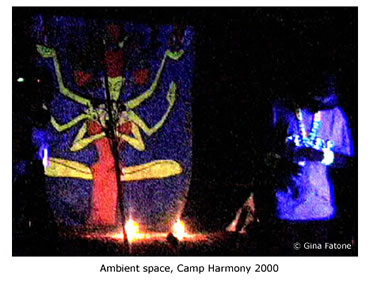 In this paper, I’d like to discuss rave as an expressive form arising as an artifact of technoculture3. First, I’ll explore the concept of rave as a technologically mediated ritual process4 within which ecstatic “trance-dancing”5 to electronically produced repetitive musical structures is a highly valued, core experience. Following this, I will examine the processes by which an American version of a Balinese gamelon6 group based in Santa Cruz, California has recently been appropriated by the San Francisco rave scene. I find that this appropriation illuminates two important aspects of a possible “rave aesthetic”: the value of a kind of musical structure commonly present in communal events leading to altered states of consciousness,7 and the juxtaposition of a nostalgia for the “primitive” and “exotic” with a reverence for high technology.
In this paper, I’d like to discuss rave as an expressive form arising as an artifact of technoculture3. First, I’ll explore the concept of rave as a technologically mediated ritual process4 within which ecstatic “trance-dancing”5 to electronically produced repetitive musical structures is a highly valued, core experience. Following this, I will examine the processes by which an American version of a Balinese gamelon6 group based in Santa Cruz, California has recently been appropriated by the San Francisco rave scene. I find that this appropriation illuminates two important aspects of a possible “rave aesthetic”: the value of a kind of musical structure commonly present in communal events leading to altered states of consciousness,7 and the juxtaposition of a nostalgia for the “primitive” and “exotic” with a reverence for high technology.
Rave, generally defined, is a particular kind of urban underground all-night8 dance party, usually held in a secret location, characterized by an aesthetic based on ecstatic experience and a heightened feeling of communitas. This idealized state of being is accomplished primarily through sensory overload—extremely loud electronically-produced dance music, a proliferation of psychedelic and other technologically produced visual images, and use of chemical enhancers9 including Ecstasy, known to produce a feeling of profound empathy in its users.10 But beyond this general definition, rave culture is far from homogenous.11 Stylistically fragmented by numerous and constantly reformulating musical subgenres which fall under the catch-all term “techno,” rave exhibits regional differences, and an event can range in size from fifty to tens of thousands of participants. However, the core values of communal ecstatic dancing, altered states of consciousness, and “the cult of the DJ”12 have been retained from rave’s early roots in New York’s gay disco culture of the 1970s.13
Listen to excerpts from DJ sets:
My discussion here will be limited to what is considered a “true” rave in the hierarchy of rave authenticity—that is, an underground dance party with homegrown artistic elements, hosted by a regional rave collective with its own distinctive identity. The “authentic” rave is reportedly distinct from what is called a “massive,”14 and also from the club scene, both of which are “above ground” events that have appropriated aesthetic elements of the “true” rave into commercialized venues.15 Although the massive scene has become highly visible, my raver consultants for this project are quick to affirm that the underground rave scene is alive and of great personal importance to them.16
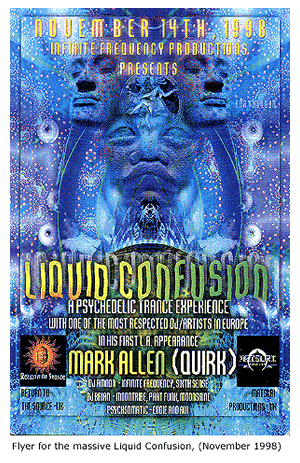 My fieldwork has so far been limited to one regional expression of rave culture: the San Francisco rave scene17 between 1997 and 2000. Any generalizations implied extend only as far as that fieldwork has taken me. Although I use the generic terms “the rave” and “the raver” in this piece, I’m referring to individuals and events within a particular enclave of rave culture with which I’ve had personal experience. San Francisco ravers are typically white middle-class youths between the ages of 18 and 30, often college students, and are usually interested in alternative culture (Brown par. 4). Amongst rave scenes, San Francisco is known for its psychedelic, New Age-y, idealistic ethos. This is due to the “wishful anarchist/spiritualist agenda” of the scene’s British founders (Silcott 51-4) which catalyzed with San Francisco’s countercultural past in the late 1980s. These themes are expressed in the titling of rave events such as Warmth, Innercense, Expansion 2.0, and Unity.
My fieldwork has so far been limited to one regional expression of rave culture: the San Francisco rave scene17 between 1997 and 2000. Any generalizations implied extend only as far as that fieldwork has taken me. Although I use the generic terms “the rave” and “the raver” in this piece, I’m referring to individuals and events within a particular enclave of rave culture with which I’ve had personal experience. San Francisco ravers are typically white middle-class youths between the ages of 18 and 30, often college students, and are usually interested in alternative culture (Brown par. 4). Amongst rave scenes, San Francisco is known for its psychedelic, New Age-y, idealistic ethos. This is due to the “wishful anarchist/spiritualist agenda” of the scene’s British founders (Silcott 51-4) which catalyzed with San Francisco’s countercultural past in the late 1980s. These themes are expressed in the titling of rave events such as Warmth, Innercense, Expansion 2.0, and Unity.
Whether parties are held indoors or outdoors, the rave space is typically distinguished by a number of simultaneously active subspaces within which DJs spin sets of different styles of music for their respective dance followings. The boundaries of these subspaces within the larger rave space are blurred—particularly in outdoor venues where there are no walled rooms to individuate the space—as the musics are played at a very high volume. Party-goers may travel from room to room or space to space during the course of a night, experiencing different styles of music, dancing, and overall aesthetic. Warehouses with multiple floors and rooms provide ideal settings for indoor parties. Walls present wonderful opportunities for creative decoration including lighting effects, the hanging of artwork, the projection of video images, and general theme and ambiance development of particular spaces. One of the most intriguing indoor rave spaces I’ve seen involved the transformation of a laser tag arena in the North Bay into an elaborate raving playground. The outdoor venue is not necessarily more creatively limited, however. By far the most mind-boggling visual effects I’ve experienced at a party included the projection of laser animation on a 500-foot wooded mountainside in the Sierras. There is a special sense of freedom, expansion, and openness that naturally occurs at an outdoor rave. A party last summer near Chico, a woman set up her telescope between the mainstage and ambient space, sharing her view of the night sky with ravers passing by.
|
Watch set up for
|
Lysloff emphasizes how music serves to delineate—and even sacralize—space and time in the context of ritual performance (Wong and Lysloff). In the case of outdoor raves, in which there are no physical boundaries, this is particularly true. The perimeters of both the rave space as a whole (marked by one cacophonous, sonic utterance, comprising all musics and activities in simultaneity that can be heard for miles), as well as the subspaces (the soft borders of which extend as far as the sound of a particular music will go until it blends into the soft borders of another subspace) are musically defined.
Return to Innocence
It is evident from the relatively small but growing body of literature concerning rave culture that so-called “tribal,” “primitive,” or “pagan” elements of the rave aesthetic are decidedly self-conscious.
| http://www.cloudfactory.org/ http://www.harmonyproductions.com/ http://www.hyperreal.org/raves/newmoon/ http://www.hyperreal.org/~spaz/ |
In logging onto one of the many rave collective web pages, for example, the self-identification of ravers with “pure,” “unadulterated,” pre-industrial society, and the romantic notion of collectively returning to tribal roots through the rave “process” is strongly apparent. The Guerillas of Harmony web page includes links to essays with titles such as “Roots of Trance Dance,” “Children of the Evolution,” “Cybertribe Rising Revisited,” and “Rave and the Rebirth of Celebration.” A raver friend of mine states in a personal interview, “I think it’s a return to innocence.”18 Quoting him further:
It has roots in prehistory. It’s like one of these big dance sessions where they would chant all night long until the sun comes up or something. That’s my personal feeling…I really think they’re tapping into something really deep in the psyche. (Personal interview, 21 May 1998)
Van Gennep establishes three theoretical stages which constitute a rite of passage, or life crises ritual in so-called “primitive” or “tribal” cultures: separation (indicating a physical separation from “everyday” space or location of activity); transition (an in-between liminal state of being where the subject is in transit from one identity to another, properly belonging to neither); and incorporation (where the subject returns to the mundane state of being and place from which s/he came, and is reintegrated into society bearing his or her changed status) (Turner, Ritual 24). Retaining van Gennep’s basic tri-partite processual model, and modifying it to account for significant contextual differences between ritual in tribal and post-industrial communities, Victor Turner proposes that it may be applied to cultural performances in technologically complex societies (Anthropology 9). For Turner, cultural performances are ritualistic by their very nature. Is it possible to successfully apply this model to rave, construing its identity as a ritual performance (pre-industrial) within the aesthetics and dynamics of technoculture (post-industrial)?
Note Turner’s characterization of ritual in “tribal” society:
…an immense orchestration of genres in available sensory codes: speech, music, singing; the presentation of elaborately worked objects, such as masks; wall-paintings; body-paintings; sculptured forms; complex many tiered shrines; costumes; dance forms with complex grammars and vocabularies of bodily movements, gestures, and facial expressions. (Anthropology 106)
I’ve personally seen every one of these elements enumerated above by Turner—save for the singing—in the context of a rave.The adjectives “magical,” “festive,” and “sacred”—all terms used by Turner to describe the “alternative worlds” created by cultural performance genres—are used to describe the rave by both participants and observers. However, to what degree an actual relationship between rave and “classic” ritual process may be contrived is another question.
The Parade of Mischief
Beginning with the initial phase (separation),Turner asserts that a passage in space,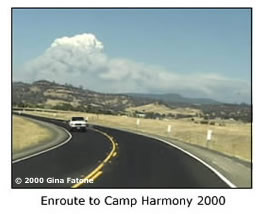 or physical relocation, occurs to symbolize the individual’s transition from pre-ritual to post-ritual status. He indicates “the spatial passage may involve a long exacting pilgrimage” (Turner, Ritual 25). A separation process fitting this criteria is indeed a significant aspect of the rave event. The actual location of the rave is usually kept a secret until the last moment, both to avoid interception by anyone who might want to prevent it from happening, and also to reinforce its underground nature. The journey to the event itself often involves a long drive to a remote location.
or physical relocation, occurs to symbolize the individual’s transition from pre-ritual to post-ritual status. He indicates “the spatial passage may involve a long exacting pilgrimage” (Turner, Ritual 25). A separation process fitting this criteria is indeed a significant aspect of the rave event. The actual location of the rave is usually kept a secret until the last moment, both to avoid interception by anyone who might want to prevent it from happening, and also to reinforce its underground nature. The journey to the event itself often involves a long drive to a remote location. 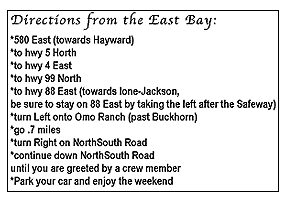 Making this “pilgrimage” to the rave further “exacting,” ravers can expect to arrive at the designated location only to find themselves at a decoy venue, faced with an additional trek to the real venue. I’ve been told this can happen several times before the true location of the event is reached, and that it is an accepted element of the night-long process.
Making this “pilgrimage” to the rave further “exacting,” ravers can expect to arrive at the designated location only to find themselves at a decoy venue, faced with an additional trek to the real venue. I’ve been told this can happen several times before the true location of the event is reached, and that it is an accepted element of the night-long process.
The transition phase of van Gennep’s three-part model is the point where participants enter an ambiguous, unstable, in-between state. Here the concept of real time is altered, participants are rendered anonymous by various means, and all manner of inverted behaviors occur (Turner, Ritual 24). The realization of communitas, which, according to Turner, is closely related to liminality, is an important aspect of this phase. In keeping with this goal, ritual participants are often cloaked in anonymity, or rendered invisible, by one means or another (Turner, Ritual 26). Once again, parallels may be drawn between this theoretical stage and things that occur in the rave context. One of the main objectives of rave participants is to reach an altered, transformed, or ecstatic state, in which it may be fair to say that the perception of time is affected. As previously mentioned, this altered state is accomplished through a combination of means designed to effect sensory bombardment. Note the objectives expressed at hyperreal.org’s FAQ website regarding how music functions at these events:
In general, the purpose of the music played at raves is to make people dance. But it is more than that: the music has to take people to another place. Most music played at raves is intended to Lose yourself in. Techno played at raves is a faceless, nameless organism, Time stops when the mind’s clock of frequent distractions is disconnected by the surreal, hypnotic Syncopated rhythms being woven around your head by the DJ. Time stops and the Vibe begins. (Brown par. 9)
Dressing up for a rave is an act of anticipation. For me, it means a conscious effort to contribute to the vibe of the party. It means wearing something I would not be comfortable wearing on the street. By dressing up, you become part of the visuals team. “Candy Rave”21 is by no means the only option for contributing to a rave by what you wear, but it is a style that lends itself particularly well to the environment. Basically any outfit that is something different from how you would normally dress in public, that shows a certain amount of effort or creativity, that shows a predilection for fun, zaniness, irreverence, etc., is something I would probably delight in seeing at a rave. (posted 11 Dec 1998)
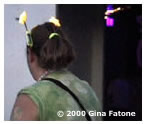
If you want to join in the Cosmic Elfs parade of Mischief, bring lasers, flashing lights, ray guns, glow sticks, funny looking hats, or the inspiration to create havoc and mischief. Acrobats, gymnasts, and pranksters encouraged. The parade of mischief starts @ 4:2022. (posted to sfraves 21 Nov 1998)
|
Watch a personal
light show at Camp Harmony 2000
(August 19, 2000) |
|
Watch Video from
|
According to Turner, the liminal phase of ritual is functional in two ways: it serves as a forum for social commentary (or “letting off steam”), and for the generation of “liminoid” phenomena (Ritual 32). “Social commentary” includes expressions of resistance to social norms or the status quo. Turner suggests that particularly in “technologically complex societies,” behavior in this phase can take the form of subversion (Ritual 41). It doesn’t take much imagination to identify resistant or radical behaviors within the context of rave: illegal drug use, disturbance of the peace (aurally speaking), and anti-mainstream rhetoric are just a few examples. Regarding the second function of the liminal phase, Turner uses the term “liminoid” to refer to the creative products of a liminal state of being. I would suggest that examples of liminoid phenomena produced at raves include the developed styles of individual DJs, the elaborate hi-tech animations of laser artists, and the building of fantastical “sets” in various rooms or spaces of the rave site, including the hanging and draping of homemade banners, strings of lights, and other miscellaneous materials and objects.
|
Watch laser artistry at Camp Harmony 2000
|
Within the elaborate playground of the rave space, Turner’s concept of liminality is applicable. For Turner, though, the absurdity of the liminal phase of the rite of passage ritual is meant to bring into dramatic relief the “the culturally defined proper order of things.” In the utopian “ideology” of raving, by contrast, the rave event points to an idealized version of how the world should be. However, the “pointed to” in rave is not the result of a dramatic representation of its opposite or inversion, as in Turner’s model. The inversions and absurdities of raving are more simply part of playing.
In the final theoretical stage of the ritual process, the aggregation or reintegration phase in Turner’s model, participants engage in “cooling down” behaviors through which they are restored to the mundane world in a changed state (Turner, Anthropology 9). I have personally never stayed at a rave all night long, but I recall the intensity with which a raver friend of mine describes the feeling:
It’s almost a rite of passage every time you go through one of these all night things. You stumble out into the cold light of dawn with this crowd of people that has been through this amazing experience together. And the bonds between the people is just incredible. I mean, you don’t really experience it if you go [leave] at 2:00 [a.m.] but if you go all the night. You sort of force yourself to keep awake, and have been through these ecstatic moments together, and been on this journey together, and now you sort of come back to reality in the morning. Sort of stumble out the door and the lights and the sun will be out…and you just kind of look at each other. There’s this incredible bond, you know it’s like you’re a big family that’s sort of gone through this together… (Personal interview, 21 May 1998
It wasn’t until I was 25 that I discovered the scene. It was like becoming color for the first time . . . The first thing I did was run out to my truck to go for a drive and listen to “follow me.” found myself unable to resist shouting with joy, dancing with all available limbs, and grinning madly at the people next to me at a traffic light! Think about it – the beauty of everything around you that you might have taken for granted (or may still): the moon shining down on the trees, the soft glow of a neon light, the beautiful fluidity of a person walking, a woman laughing; the smell of fresh air, the taste of cold water… There is no predictability, there is no order – there is only exquisite randomness of the universe and this amazing existence that we find ourselves in. I love being awake, I love having my eyes open, I love every moment that I’m alive. I’ve been painted by the brush of raving with a palette of vibes, people, love, music, unity, movement, peace, and togetherness. I am in color. (posted to sfraves 13 June 2000) Development of rewarding alternatives, including a sense of belonging in “straight” society, is a critical aspect in treating young people involved in these drug-dominated cultures.
Psychiatric Annals, March 1994.23
Effusive testimonials describing a first rave experience are quite common. This may be connected to an intense feeling of communitas often experienced (related to PLUR), a level of heightened sensory/aesthetic gratification perhaps not previously experienced, a mind-expanding drug experience, or perhaps a combination of these. William Wedenoja, in discussing the psychosocial effects of ritual stimulation, suggests that the emotional, physiological and cortical states of a collective group may be “synchronized” when group members are all exposed to the same “driving stimuli,” and that a sense of communitas might result from this synchronization (Wedenoja 285).24 He adds that a state of exhilaration may serve as a reinforcement agent in group cohesion. Along these same lines, Judith Becker states that rhythmic entrainment “invokes realms of knowledge to which we otherwise have little access and provides a deep and sometimes abiding sense of well-being” (Becker 50).
Whatever the causes of this euphoric or oceanic experience within rave, it is important to note and (for the purposes of this discussion) that this state is relatively temporary and does not constitute a change in the social status of the individual. Unlike the rite of passage model, ravers don’t really transition from one social status to another during the course of a party and emerge permanently changed in the eyes of society. (Yet in a larger sense, rave might be viewed as a playing with the transition from adolescence to adulthood.) Rather, it seems, rave-goers enter a ritual, liminal, play-inducing space, they do their thing, and then they exit that space. Ravers do indeed reenter the mundane world after a rave, and although there is much testifying to a personal and perhaps even a spiritual transformation as a result of raving, a transformation in the kind of social status that rites of passage theoretically incur (e.g., marriage, transition to the afterlife, adulthood) is more difficult to argue.
With regard to specific “cooling down” behaviors indicated in the third stage of Turner’s model, the post-performance period of the rave is formalized through a “chilling out” that takes place in virtual space the day after the event. Raves usually take place on Friday and Saturday nights. Over the course of the remainder of the weekend, rave participants “meet” on the internet to discuss what they liked or didn’t like about the event, and to submit informal reviews about particular DJs or other aspects of the experience. Note the following examples:
Oh yeah, I forgot to mention that the visuals were out of this friggin world!!!!!!!!!! Not only was the whole video game thing totally cool, but did anybody see the faces that were slowly morphing into other faces, or what looked like time-elapsed photography of a vine wrapping around a stick or some weird stuff like that? I wasn’t even f-ed up but the visuals were making me trip out. (posted to sfraves 23 November 1998)I do gotta say that Warmth was one of the best raves I’ve been to since the last Warmth…I know tha music was going off in all three rooms, but I was completely stuck in tha jungle room for about the entire night with the exception of a few fruit runs (tell me you don’t love pineapple when you’re on e). So as you know, the music in the jungle room was sick as fuck. At Audio Impact Jamalski kicked this dope ass flow to me about ecstasy and mushroom tea (the music was off the hook there too) and he was fucking shit up at Warmth…Hak and Siphon all REPRESENTED and showed this girl much love with some SICK ASS BEATS!!! Lord knows I was loving it. Yeah so if you were in there I was in a snakeskin print dress dancing my ass off loving every beat in front and behind the turntables like 4 tha whole night. (posted to sfraves 22 November 1998)
“I’ve been painted by the brush of raving… I am in color”
Another model of ritual experience, namely, T.J. Scheff’s psychoanalytic theory of catharsis in ritual healing, offers what may be a more useful analytic frame for this discussion of rave as ritual. Scheff’s work, an adaptation of Freud’s well-known catharsis theory, has been used by Carol Laderman in an analysis of Malay shamanistic healing,25 and referred to by William Wedenoja in conjunction with his work with the Revival ritual trance cult in Jamaica. According to Scheff, there are three elements or stages in the ritual cathartic process: an “emotional distress” (classically caused by a repressed emotion from a past traumatic experience), an aesthetic “distancing element” (something that allows an individual to be simultaneously both participant and observer of a re-enactment of that bad experience), and finally, a cathartic discharge or release of emotion. Scheff extends the application of this model from the individual psychotherapeutic context to mass entertainment rituals such as watching movies and sports games, hypothesizing that these activities fill a void in modern society created by the severance of “the connection between strong emotion and ritual” (Scheff 128). If we broaden the definition of “emotional distress” and allow for distancing elements that do not necessarily represent re-enactments of bad past experiences, this model may work well for rave.
If we cast rave as a cathartic ritual, what can we identify as the “emotional distress” in need of release?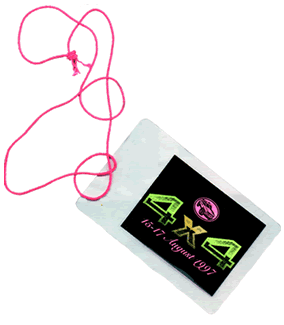 Unlike the healing rituals described by Laderman and patients undergoing psychoanalytic “treatment” discussed by Scheff, there is no identifiable overt “sickness” that needs to be healed, or particular repressed emotions of past trauma to be relived, in the case of rave participants. As Wedenoja in fact suggests, an abnormal psychic conflict or illness need not be a prerequisite to ritual participation (Wedenoja 298). Scheff himself posits that rituals provide “occasions of repeated catharsis” for all members of society who in the normal course of life need to release accumulated “distressful emotion” (Scheff 116). I suggest that rave enables the release of normal youthful energy, rebelliousness, and social anxiety—and perhaps the reliving of childlike play in an emotionally safe environment. Considering the age group involved, one might also acknowledge the stress of transitioning from adolescence to adulthood, which can be quite tumultuous.
Unlike the healing rituals described by Laderman and patients undergoing psychoanalytic “treatment” discussed by Scheff, there is no identifiable overt “sickness” that needs to be healed, or particular repressed emotions of past trauma to be relived, in the case of rave participants. As Wedenoja in fact suggests, an abnormal psychic conflict or illness need not be a prerequisite to ritual participation (Wedenoja 298). Scheff himself posits that rituals provide “occasions of repeated catharsis” for all members of society who in the normal course of life need to release accumulated “distressful emotion” (Scheff 116). I suggest that rave enables the release of normal youthful energy, rebelliousness, and social anxiety—and perhaps the reliving of childlike play in an emotionally safe environment. Considering the age group involved, one might also acknowledge the stress of transitioning from adolescence to adulthood, which can be quite tumultuous.
According to Scheff, in order for cathartic ritual to be optimally effective, the distancing element must strike a perfect balance between belief and disbelief in the minds of participants. Functioning in this “double vision” mode, the ritual communicant must be both participant and observer of the drama in which s/he is engaged (Scheff 119). If either “underdistancing” or “overdistancing” takes place, the cathartic process will fail. In the case of rave, the participant’s knowledge that s/he is performing/playing in a temporary time-space removed from the non-rave world, serves as a distancing device. Through the anonymity afforded by darkness, dress-up, clowning, and other liminal playing in a self-consciously childlike fantasy world, liminality itself also functions as a distancing element. Ravers are provided the opportunity for dramatic play with identities and ways of being that they don’t normally engage in, within a safe space set aside for this purpose. Play with belief in supernatural entities (such as the Technology Goddess), with romantic images of perfect, primordial communities and consciousness, and with the myth of dancing the world to its former state of perfection, are also examples of aesthetic distancing found in rave.
We might say that the catharsis that takes place in what Turner would call the liminal phase of rave results in an emotional transformation of the participant, who likely enters the event with normal tensions and pent-up youthful energy and exits having blown off a good deal of steam. Activities resulting in cathartic release of rave are easy to identify. Hours of unrestrained dancing to the point of exhaustion, the satisfaction of engaging in “subversive” and/or hedonistic behaviors, and a general sensory exhausting, are examples that easily come to mind. Therapeutic results of raving may include escape from everyday life situations, the experience of others on an emotionally intense level or with a closeness that may not be available in ordinary social life, a sense of group belongingness, and the socially validating sense of being a part of something “special” that is different from what most people experience.
In the distancing phases of Scheff’s cathartic process, (in both ritual healing and mass entertainment rituals) there is a structural separation between the individuals that are undergoing a particular rite, the healer or shaman who enables the cathartic process, and the “audience” in attendance. In the case of rave, this separation doesn’t really exist. Ravers are both actors and audience simultaneously participating in a cathartic ritual. Although much has been made of the “cult of the DJ,” attention has also been given to the “leveling” of rave participants regardless of role. Rave presents a situation where there is no star and no differentiation between performers and audience. Note the following quote by a DJ posted on sfraves:
Someone once asked me if I felt like a pilot when I DJ and if everyone dancing felt like my passengers. ‘No,’ I said, ‘everybody dancing should be a pilot. I want to be the weather. (DJ Lotus, Toronto, date unknown)
Rave as a cultural performance is constituted by participants performing for each other and feeding off each other, creating a dynamic exchange of creative—and sometimes transcendent and ecstatic—energy. This phenomenon is perhaps similar to what Jihad Racy describes as an “ecstatic feedback model” of Arabic music performance.26 I would argue for an expansion of existing cathartic ritual theory to include performance structures that accommodate less differentiated roles among actors such as rave.
In summary, although rave does not hold up to scrutiny as a rite of passage ritual in particular, this examination suggests that rave as a cultural performance nevertheless makes use of ritual elements that are powerfully efficacious and meaningful to its participants. Turner’s position that cultural performances are ritualistic is compatible with Scheff’s presentation of the theory of catharsis in ritual. Each model has been useful here. With reference to Scheff’s idea that rituals provide opportunities for repeated catharsis, it would be interesting to investigate at which point in an individual’s “raving career” does rave ritual cease to function in this capacity. When does the cathartic power of the ritual lose its effectiveness? At what point does a party-goer’s experience of rave become “underdistanced” or “overdistanced” leading, in Scheff’s theory, to its failure? And does this loss of efficacy signal a personal transition in the life of a rave participant?
The Will of the Goddess
It may be valid to argue that raving is essentially a continuation of an ancient performative behavior and nothing fundamentally new. However, the essential components by which a rave identifies itself as a rave are technologically produced, and beyond this, social relations between participants are mediated by technology. I’ve mentioned that the liminal phase of the rave process is experienced spiritually. It has been noted by several writers that a main motivation for participation in a rave is to become immersed in the feeling of communitas that is generated at the event. It is significant to note that this communitas (or even ecstatic trance) is achieved through hi-tech means—particularly through mass dancing to music comprised of simulated and sampled sounds, often enhanced by pharmaceutical technology.27 In Generation Ecstasy, Simon Reynolds refers to the various musics (or “hallucinogenres” of rave) as “sampladelia,” or “perception-warping music” which deconstructs “the metaphysics of presence” (Reynolds 41, 44). Ravers, involved in what they themselves term “ecstatic trance dancing,” speak of submitting themselves to the will of the DJ, often referred to as a shaman. Hence the term “technoshamanism“ is used by participants to denote this essentializing aspect of the rave.
House music is the sound of the cultural blender running at warp speed. It’s a techno-shamanic dervish. (Heley)
As René Lysloff writes, “trance is actualized via the interaction of the human and the machine, implicating a postmodern “secular religion” where technology itself is worshipped” (“DJ Shamanism” 11). In fact, the credo of technopaganism may be found at hyperreal.org, along with prayers such as “We thank the Technology Goddess for giving us the ability to rave”…“We finally wish that the Technology Goddess will receive our ecstasy while raving as an offering and a celebration of her omnipotence.” This ethos of abandoning oneself to the will of the machine and dissolving into a communal mass of dancers has remained one of rave’s most salient aspects, dating back to proto-rave techno of the early 1980s.28
The rave event is also distinguished as a technocultural artifact by the fact that its planning phase, as well as its restoration phase, takes place in virtual space. This forum, in scope and nature of social relationship, is not something that could be replicated in reality. The anonymity afforded by faceless interaction in virtual space, it has been noted, leads to the kinds of interactions that would not take place in real life, due to actual or perceived censure of the content of the message. As the drug Ecstasy removes fear, allegedly the element which controls our behavior29 for the purpose of establishing a greater communitas, I suggest that the virtual forum serves as an extension of this chemical agent for the raver. Technology additionally mediates social interaction in the rave scene through the sheer volume of the music—a situation which dictates that the nature of communication between participants will be non-verbal.
“Maybe ya shouldn’t dance when folks is prayin'”
We construct our technologies, and our technologies construct us and our times. (Turkle 46)
Anak Swarasanti is a type of ceremonial orchestra known in Bali asgamelanangklung. It is a 4-tone ensemble consisting primarily of four-keyed bronze metallophones of different sizes or registers, the keys of which are suspended over bamboo resonators. Other instruments of the gamelanangklung include a horizontally mounted row of knobbed gongs, two drums, a small pair of cymbals, bamboo flute, a small vertically suspended gong, and a small horizontally mounted gong used for time-keeping (Tenzer 86).32
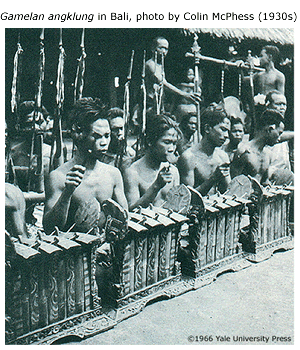 festivals.It is one of three theoretically required ceremonial gamelan in village ritual life (along with the larger gamelan gong, and the processional orchestra gamelan beleganjur) (McPhee 6; Bakan 11). Although the ensemble has traditionally served a Hindu-Bali ceremonial function, performances of contemporary music, or adaptations of non-ceremonial pieces for gamelan angklunghave more recently begun to take place in various secular settings (Sedana, letter). gamelan angklung groups now take part in government sponsored gamelan competitions (Bakan 97). And while membership in gamelan angklunggroups has traditionally been confined to males, females have lately been seen performing this music in Balinese conservatory settings (Sedana, letter).
festivals.It is one of three theoretically required ceremonial gamelan in village ritual life (along with the larger gamelan gong, and the processional orchestra gamelan beleganjur) (McPhee 6; Bakan 11). Although the ensemble has traditionally served a Hindu-Bali ceremonial function, performances of contemporary music, or adaptations of non-ceremonial pieces for gamelan angklunghave more recently begun to take place in various secular settings (Sedana, letter). gamelan angklung groups now take part in government sponsored gamelan competitions (Bakan 97). And while membership in gamelan angklunggroups has traditionally been confined to males, females have lately been seen performing this music in Balinese conservatory settings (Sedana, letter).
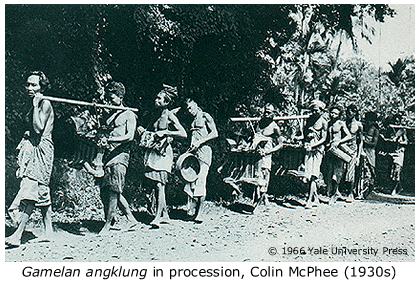
|
Watch gamelan angklung rehearsal in Denpasar, Bali (September 1990)
|
|
Listen to secular music adapted for gamelan angklung (angklung kebyar genre) |
In Northern California, gamelan angklung Anak Swarasanti rehearses weekly and performs fairly regularly in the Santa Cruz community. Some of the group’s appearances have included “ceremonial” functions (such as First Night Santa Cruz, and the opening of a film festival at a downtown movie theater), but most performances are purely for entertainment (e.g., a benefit for a Tibetan health program, summer music festivals, college performances, and local garden parties).
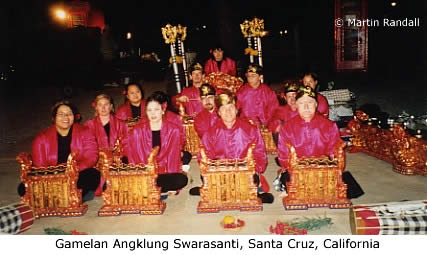
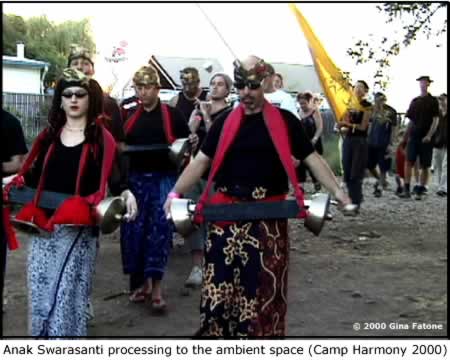
|
Watch Anak Swarasanti play marching gamelan at Camp Harmony 2000
|
The Anak Swarasanti website includes descriptions and photos of its various performance venues. The gamelan’s membership is mixed in gender (currently 3 females, 7 males) and age (24-45). Members are either working professionals (most are in the hi-tech industry) or university students (including one music major).
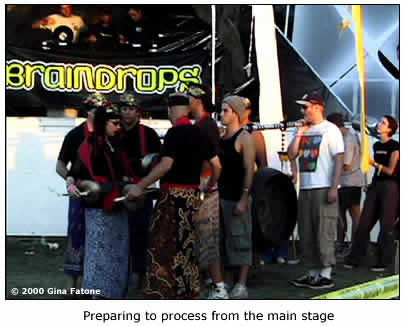
The repertoire performed by this American group includes traditional and contemporary compositions for gamelan.
|
Listen to excerpts of traditional angklungpieces from Anak’s 1998 CD
|
“Pebaktin”
“Gilak” “1941” |
Compositions for gamelan angklung are cyclical in form, enabling them to be shortened or lengthened depending on the demands of the performance context. In the rave context, in which Anak Swarasanti is normally expected to play a set several hours long, the group collectively arranges extended versions of traditional ceremonial pieces.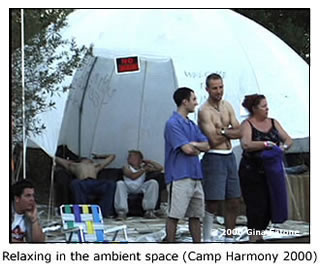 At raves the group always performs in what is known as the “ambient space.”(pictured below)This is a room or space set apart from the main dance location(s), where ravers can come at any point during the evening to “chill out,” or take a breather from the more extreme goings-on at the event. Although some dancing does take place here, people usually use the space to be still (sometimes frighteningly still). There are usually mattresses to lie on or rugs to sit on. The music in the ambient space (usually of the ambient subgenre) is generally calmer, quieter, may be rhythmic or non-rhythmic, and is meant to function in an atmospheric way.
At raves the group always performs in what is known as the “ambient space.”(pictured below)This is a room or space set apart from the main dance location(s), where ravers can come at any point during the evening to “chill out,” or take a breather from the more extreme goings-on at the event. Although some dancing does take place here, people usually use the space to be still (sometimes frighteningly still). There are usually mattresses to lie on or rugs to sit on. The music in the ambient space (usually of the ambient subgenre) is generally calmer, quieter, may be rhythmic or non-rhythmic, and is meant to function in an atmospheric way.
|
Watch video of ambient space at Harmony 2000
|
|
A traditional blessing: watch a musician sprinkle holy water on the gamelan
|
The gamelan (although always rhythmic), with its seamless, minimalist, and repetitively structured sounds, fits well into this scheme. However, its presentation is almost always mediated by the addition of a layer of technologically-produced music added to the texture. This is not meant to be a simple overlay of synthesized music contributing to the generalized ethereal soundscape of the ambient space, but an interactive relationship between rave musicians and the gamelan. This ideal is illustrated by the following excerpt of an email sent by a member of Anak Swarasanti when the group was in the planning stages of a rave appearance in the spring of 2000.
-
– start off with a fast piece, followed by a slow piece. that will keep
people interested from the start, and then you can decide from their reactions if they want an ambient meditative set or a more upbeat dancable set. basically, have two lineups ready to play, one more ambient, the other more energized, and then just choose which one is appropriate based on the response of the first two songs.– cut the gig in half. it was a little long for people who are there to rave.- use more of the big gongs. for example: have the gongs match beats with the dj, phase the dj out, bring in the gamelan, and reverse that at the end of the gamelan set. possibly even keep the gongs (in different varieties) playing continously between songs, so there is no silence. participation (like dancing or meditation) is much easier with continued sound, rather than silence between songs (which is more like a concert, where concerts are generally nonparticipatory).And this from a DJ to the sfraves list:
I’ve been banging my head against a rock trying to
figureout what to play during my slot. So…I will be taking the eternal crack posse into a musical dimension of
sounds from just about every genre because I can’t think of anything elset o play on the techno system from 6pm till 7:30 (right after Joey Mazolla and before MAC of the North). Should be interesting… we’ll see what happens.Immediately afterwards, I hope to be joining the gamelan Anak Swarasanti in the ambient area for a special marathon sunset peformance. For those of you who have missed previous performances of this gamelan… these are an incredible performance experience, practicing an ever developing traditional form from Bali that has elements that have only really been
explored in western music at an esoteric level through the 20th century composers and a few really interesting bands in more popular music (sonic youth, primus, king crimson, mbv). If you’ve been looking for music historically associated with hypnotic mental states, this is the real stuff… all presented with great reverence for the culture from which it came (and a gong that I love sitting next to cause it just goes BBBBBBAAAAAAAAAHAHHHHHHHnnnnnHnnnHHHHHHHHHMMMMmmmmmmmmm
nnnnnmmmmmm…).I’ll be joining them with a [computer] notebook running some bizarre german sound design software and digital effects on some instruments in the ensemble… so expect a collage of audio textures that balances somewhere between futuristic electronic experimental works with the awe inspiring interlocking cyclical progressions from across the pacific. (DJ AndyW, posted 15 August 2000)
Listen to an excerpt from Anak Swarasanti’s first appearance at a rave in 1997
Although I have yet to discuss this with the event organizers, I believe that the sound of the gamelan “unplugged,” with its sharply contrasting non-synthesized timbre, would be like a rip in the acoustic fabric of the carefully designed aural space, causing a disturbance in the ravers’ aesthetic experience.34 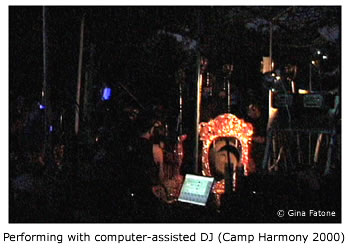 With regard to additional technological mediation, aside from the dialogue between sample-based music and the gamelan, Anak Swarasanti is usually located within a psychedelic “set” in the ambient space. The group normally performs on a platform surrounded by blacklight-activated banners and other lighting paraphernalia.
With regard to additional technological mediation, aside from the dialogue between sample-based music and the gamelan, Anak Swarasanti is usually located within a psychedelic “set” in the ambient space. The group normally performs on a platform surrounded by blacklight-activated banners and other lighting paraphernalia.
|
Watch Anak Swarasanti at early evening ambient space, Harmony 2000
|
|
Watch Anak Swaransanti in the ambient space at Expansion 2.0
|
|
Watch Anak Swarasanti’s early evening performance at Harmony’s 4×4
|

Comments posted to the sfraves discussion list, along with repeat invitations to perform at raves in the Bay area, underscore the successful appropriation of the gamelan by the San Francisco rave scene.
…as I melted through the visible sound atmosphere plastic polyester neon vibrant flower piece, my soul radiating from my eyes and every other inch of my joyful physical and spiritual being. Got there and Hak was just tearing that room to pieces making the floor bounce with his wicked vibey jungle….then I reached a nirvana/euphoric state sitting right in front of the gamelanorchestra, absorbing their message and sending it back with equal love. (posted 26 March 2000)i must say that it is rare these days for parties to be throw for the
right reason at all… i grew up in the early moon tribe era and have always used dance to find my Self but lately the parties seem to be all about getting fucked on 3 hits of e and running around yelling plur (which most people don’t live by to begin with), excuse me if i sound jaded, it is not my intention…warmth was a lovely party, i especially enjoyed dancing to the space of the gamelan (despite the mocking i received from the muscle boys)… all in all though, it was a wonderful event and i hope this time is a turning point within the scene (underground or not) and that the events will return to their spiritual roots… (posted 26 March 2000)Well, I figured I’d put down my thoughts on Warmth this past Saturday. Overall I thought the party rocked. I definately loved the gamelan. I have heard gamalan before of a different style, and saturday’s set was much more listenable to me. I danced a bit toward the end of the gamelan set, but wished more folks were dancing so I wouldn’t feel so self conscous 🙂 But maybe ya shouldn’t dance when folks is prayin 🙂 I also wished they had orchestrated the switch from gamelan back to dj’s a bit better so that there could have been more of a conection. . . .It just kinda felt like BAM! back from ecstatic music to THUMP THUMP THUMP. (posted 27 March 2000)To: sfraves@hyperreal.org
Subject: Re: Help! I need Complex Music!If you want to step outside of electronic dance music, Bach fugues are the most complex things you’ll find in western music prior to about 1900.I STRONGLY recommend that you listen to some gamelan. There are two types of gamelan, Javanese and Balinese, which are closely related to one another (I personally prefer Balinese). The music is played on sets of tuned gongs, metallophones (sort of like xylophones), one drum, and occaisionally a stringed instrument or voices. The slower pieces tend to sound like trance, the faster stuff is like jungle played at twice the normal speed. I believe COTS had a gamelan group play at sunshine of your love–can anyone post some reactions to that? (posted 23 March 2000)
How is this musical texture related togamelan angklung? Colin McPhee, in his landmark documentation of Balinese instrumental music (Music in Bali, written in 1966), distinguishes between two general forms or textures of traditional gamelan angklung compositions. In the first form, which he designates as type A, the melody line is played by the largest bass sounding metallophones in the ensemble (called jegogan) while the higher pitched instruments play a continuous accompaniment of closely interlocking figuration patterns. In the second type of orchestration, type B, the melody is played by the smaller, higher metallophones (called gendèr) and the horizontally mounted gong row (réong), while the jegogan “underline” the melody (McPhee 246).
|
Listen to type A
|
Listen to type B
|
I find the texture of the type A composition for gamelan angklung, with its rather hypnotic, minimalist figuration over a slow moving melody and metronomic tempo, to be most similar in “aural feel” to certain types of techno music.
|
Listen, for example, to this excerpt from the Orb classic “Little Fluffy Clouds.”
|
Coincidentally or not, types of techno and gamelan music, and their respective musical textures, are both present in communal gatherings where dance and altered states of consciousness are the intention of at least a subgroup of participants. Institutionalized occasions for entranced dancing (with gamelan orchestra accompaniment) in Bali include the Kris dance (male, group trance ritual involving dancers who turn knives on themselves yet remain unharmed) and the Barong/Rangda ritual (protector dragon vs. monstrous witch in a showdown between the forces of good and evil). Both dances are part of the sixteenth century Calonarong ritual play (Tenzer, 83). The larger 5-tone gamelan pelegongan orchestra, with 13-15 keyed gendèrs, accompanies these dramas involving trance. The repertoire of this gamelan again involves intricate, closely interlocked figuration played by the higher instruments in the ensemble, as well as complex stratified polyphony. Although the dramatic accompaniment requires sudden changes in tempo and dynamics at times, repetitive clichéd figurations over ostinatos and stretches of metronomic tempo remain characteristic of the music. McPhee describes the interlocking figuration occurring in certain slow moving passages:
A very different kind of musical training is required for the syncopated, percussive kotèkan figuration, performed at high speed by a group of eight or ten players. Composed of two rhythmically opposing parts which, like the rèongan of the gamelan gong, interlock to create a perpetual flow of sound, the kotèkan adds sheen and intensity to the music, and calls for the utmost rhythmic precision. (McPhee 162)
In Rouget’s oft-cited work Music and Trance: A Theory of the Relations between Music and Possession, the author states that although music “does play a part in triggering and maintaining the trance state, it does not owe its effect to the properties of the musical structure, or if it does, it does so only to a small degree” (Rouget 96). Becker applauds Rouget for “putting to rest” the idea of a causal relationship between types of music and types of trance (Becker 41). It is generally understood that the entire trance context as a package—including all sensory stimulation, in addition to the culturally-situated belief system and expectations of the participant—is responsible for inducing altered states of consciousness. Becker suggests that the musical component of trance, acting as a “physiological metonym,” “invokes” an entire “mythology” to which certain emotions and behavior are attached (Becker 45). In Bali, other deeply sensual “cues,” such as incense, strongly scented flowers, and brightly ornate costumes, accompany ritual. It is likely that in the rave context the volume of the music, the bombardment of visuals, the physiological excitement of dance, the desire for an altered state, and the other elements of rave described earlier, heighten the “transportative mechanisms” of the music. However, the musical contribution (or “universal” relationship of music) to trance states remains debated amongst scholars, and I am hard pressed to take issue with the commonly expressed experiences of many people who feel entrained, “transported,” or experience some other hypnotic-like effect when exposed to the musical textures described above, even in a sterile concert hall. Another significant issue here, perhaps a topic for another paper, concerns exactly what ravers mean when they use the term “trance” and speak of the “trance experience.” Perhaps clarity lies in a distinction between rhythmic entrainment, trance, and other forms of altered consciousness.
The New Epic Poetry
I’ve suggested that one possibility for the appropriation of Balinese gamelan by the rave scene is a similarity in musical structures typically accompanying settings/venues associated with altered states of consciousness in both contexts. Now I’ll explore the implications of a second possibility. I propose that it is part of the ideology of a segment of rave participants to associate themselves with icons of a generic “ethnic-ness”—perceived as synonymous with “primitiveness,” and the
s an “exotic entity” affords this association. Note one raver’s ideas about how the gamelan might function at an event:
I think it would be REALLY cool to have a couple of Balinese dancers dance to the last gamelanpiece, and then have the dj start back up with something similarly exotic, maybe Middle Eastern, that the dancers could also dance to. Then bring up the music again slowly, to help tie the different pieces of the ceremony together. (posted to sfraves 27 March 2000)
A further exploration of this ideology will illuminate the seemingly contradictory techno-primitive aesthetic of the San Francisco rave scene.
Another rave participant explains, “What the gamelan was doing was the same as what rave was doing. That it’s all tapping into the same roots” (Personal interview, 21 May 1998). This comment, alluding to “the same roots” of a common, pre-industrial ancestry, emphasizes the valued connection between raving and ancient ritual—a connection which serves to distinguish ravers ideologically from what they perceive as industrialized, “mainstream” society. What is especially interesting in the ravers’ worldview, is that hi-technology (the ultimate product of industrialized society) and especially technologically produced music, are seen as a means to accomplish this goal of reconnection with the primitive in us all. Far from contradictory, combining hi-technology with perceived “tribal values” is viewed as the ultimate tool of collective transcendence and self-actualization. This vision is clearly expressed by the following characterization of the rave process that appears on the hyperreal.org website:
There is a pulsating awareness of sharing archaic understandings, reviving lost traditions…which are all invested with new technological innovation. The sounds are the new epic poetry of this century… The knowledge is beyond consumerism and materialism, and associated disaffected, alienated and generally self-destructive style of the industrial being…The sounds and rhythms produced by tekno artists seem to be more and more profound in their ability to communicate the most… deeply resonating primal understandings. It’s the re-discovered language of transcendence… Here is the ‘coming of age’ ritual which Western culture has long forgotten…
I don’t mean to suggest that all ravers have the same experience, or share the same philosophy of raving. As Gore states, “Rave is multiple” (Gore 65). In fact, there have been complaints recently amongst participants (particularly from more seasoned ravers) that the scene is not what it used to be, and that many “newbies” don’t understand or don’t care about the ideals that raving was founded upon. A mere 24-hour subscription to the sfraves discussion list will reveal multiple layers and levels of experience, meaning, and engagement, ranging from the flaming and name-calling of a community member for posting a naked photo of someone’s girlfriend on the list, to the deeply philosophical and ecstatic expressions of transformational experience. Some ravers go to parties get high, others to dance, others just to listen, and the same raver may experience different levels of engagement at different events or at the same event. Likewise, the presence of the gamelan at the rave undoubtedly means different things to different people, ranging from “this is boring and weird and I don’t know what it’s doing here” to “the gamelan is doing what rave is doing.” Amongst the “multiplicities,” I have chosen to examine the experience through the lens of techno-primitivism because this ideology/aesthetic is most prominent in self-representations of the San Francisco scene in cyberspace, as well as in the literature about San Francisco raving.
When viewed from a techno-primitive perspective, the appropriation of the gamelan by the San Francisco rave scene seems like a logical process. The gamelan is successfully integrated into the rave, in part on the basis of its perceived homogenous ethnic-ness, otherness, or primitive associations—in other words, for what it represents. This representation is effected through the “exotic” appearance of the gamelan instruments—intricately carved and painted, sitting amongst carefully prepared offerings, burning incense, and other miscellaneous Balinese “paraphernalia”—and the “otherworldly” sound of an orchestra of bronze gongs and metallophones. I propose that information about where this ensemble comes from, its history, its “authentic” performance practice, who usually plays it, or even what it is called, is irrelevant in the context of the rave. It is not necessary to possess such in-depth knowledge. What is important is that the presence of the gamelan affirms the somewhat romantic, self-perceived identity of the rave collective as part of something “primal,” and as something that resists the mainstream. I am suggesting that the “exotic” = the “primitive” which is associated with the roots of humankind and the right living to which ravers wish to return.
There are many developments in technology however, that have the potential to create an electronic re-tribalization of society and help humanity remember our place on this sacred sphere.37
Although this article has focused on one regional manifestation of rave, examining the values and operative modes of this late-twentieth-century musical subculture allows us to conceptualize the idea of expressive forms arising as artifacts of technoculture. Additionally, this examination brings into relief a now commonplace mode of navigation through a world that often seems overladen with extraneous stimuli and on the verge of producing human perceptual overload. It has been noted that we as members of postmodern industrial societies must increasingly become able to sift through the glut of information and “separate the wheat from the chaff” in order keep our brains from shorting out. Maybe “satisfaction with representation/surface knowledge” is a way of filtering through the glut of cultural things. Instead of weeding out “the incoming” for lack of psychic/perceptual space, an alternative strategy, perhaps, is to reduce the depth of incoming things. (Analogous to maintaining space in your hard disk by reducing the k in your files rather than deleting them?) Whether this alternative mode of navigation through the “stuff” of “the postmodern experience” is ultimately more or less taxing sociologically, as well as psychologically, is another question.
To summarize, via technologically produced sensory experience, community in virtual space, attributing cosmic significance to technology, and interaction with technologically disembodied entities, raving in San Francisco is firmly located in the technocultural present. My intent for this project was to consider how and why a Balinese gamelan could have possibly made its way to the foothills of the Sierra mountains in the summer of 1997, and to make a contribution to the discussion of rave as a subculture in the U.S. along the way. To date only Mireille Silcott has focused on rave as a phenomenon in the U.S. Most (off-web) contributions focus on raving in the U.K., where the subculture originally developed. However, there is a wealth of information on U.S. raving on the web, predominantly insiders’ personal accounts of the subjective rave experience as well as abstractions and philosophies of the culture. Apart from my personal attendance at events in the Bay Area and interviews with participant-friends, rave’s own literature in virtual space served as a primary ethnographic site as this paper unfolded; a happenstance that could not have more aptly designated this expressive genre as an artifact of technoculture.39
Finally, as technology and technoculture are by definition in a constant state of change, so the space in which the rave event takes place is always a temporary and transient one. The actuality of each event, in all it uniqueness, simultaneity, and dynamism, seems to be constituted by its temporary and therefore elusive nature. Referring back to the “one cacophonous sonic utterance” of the total rave, I might characterize this underground utterance as a loud, defiant, powerful, ritual claim to space. There’s something about the transitory, yet very “proactive,” rave event that reminds me of the driver of an over-amped car stereo that drives through your neighborhood, staking out a piece of “aural territory,” moving along, thereby avoiding apprehension. She knows you hear her—she has forced herself on your aural space through sheer volume. She wants to be heard, yet remains aloof and perhaps separate. But there is autonomy and power in the transitory nature of his actions; she knows you won’t come out looking to silence her, because you know in that time she’ll be gone.
Gina Andrea Fatone
University of California, Los Angeles
- ↩
- The use of technology in spiritual development. ↩
- Cultural practice characterized by creative strategies of technological adaptation, avoidance, subversion, or resistance (René Lysloff). ↩
- Rave is commonly referred to as ritualistic. See, for example, Gore, “The Beat Goes On,” in Helen Roberts, ed., Dance in the City 52–56; Reynolds, Generation Ecstasy: into the World of Techno and Rave Culture 241–242; Silcott, Rave America: New School Dancescapes 54; Saunders, “The Spiritual Aspect of Rave Culture” par. 1, Accessed 13 February 1998; Somberg, “Rave as Ritual: Creating Community in a Postmodern Society” pars. 1–8. ↩
- “A free-form, liquid method of dance that attempts to bring the body and soul into harmony and provide a transformative experience in a tribal setting.” -Apollo (SF rave old schooler)
“A style of dancing where external awareness is secondary to internal phenomenae. often with loose limbs and flailing arms, you see it usually at parties where the music is of a
primal characteristic. rather than presenting visual forms for someone
appreciating the dance, it is a pure expression of music as it relates to
e-motion in the human body.” -AndyW (SF rave dj) ↩ - An Indonesian orchestral ensemble comprised primarily of bronze keyed-metallophones, gongs, and gong-chime instruments. The predominant texture of gamelan music involves multiple layers of interlocked, repetitive, metronomic cycles of sound. ↩
- The relationship between music and trance remains highly controversial. See the classic text on the subject, Gilbert Rouget, Music and Trance: A Theory of the Relationships between Music and Possession. A variety of arguments appear in James Porter, et al., “Trance, Music, and Music/Trance Relations: a Symposium.” ↩
- Some rave activities occur during the daytime. The ASR (Always Something to Remember) collective, and other rave crews, fairly regularly put on parties in public parks. ↩
- Rave parties are generally characterized by drug use, but it’s important to note that there are many rave participants who do not use drugs. There are plenty of participants who believe the sensorial experience of a rave does not require chemical “enhancement.” ↩
- On the musico-perceptual effects of, and bodily response to, combining MDMA (Ecstasy) with repetitive, rhythmic music, see Matthew Collin, Altered State: The Story of Ecstasy Culture and Acid House 27–28, and Reynolds 81–86. ↩
- On the slippery task of defining the rave movement, see Gore 50–51. ↩
- There have been numerous references made to the DJ as a shaman or cult figure leading ravers to a transcendental experience. See, for example, Gore 52, 61–65; Lysloff, “DJ Shamanism and New Age Technospirituality: Trance and Meditation in Popular Music;” Fikentscher, “‘You’d Better Work’: Music, Dance, and Marginality in Underground Dance Clubs of New York City;” and Reynolds 35. ↩
- See Reynolds 13–37. ↩
- A raver explains:
I don’t think there’s any official definition of a massive—it’s just a big, generally horribly commercial party. How big does it have to be to qualify as a massive? You’ll get a huge range of answers—old-schoolers might say anything more than about 300 people, others would say starting at around 2,000 (realistically I’d give the 2,000 number myself). Because they are so big and commercially publicized, they tend to attract the high-school kids who think they can become “ravers” by putting on some plastic beads and buying e from the first person they find, and spending the rest of the night passed out on the floor. The “real” ravers are connected into the underground and won’t go to most massives (although massives can afford to bring in bigger name dj’s that smaller undergrounds could never afford, so occasionally people may grudgingly go just to see their favourite international dj). Also massives have their uses in that many newbies arrive in the scene through massives and the few truly dedicated people may eventually filter through the system and find their way into the underground—hopefully the underground does a good enough filtering job (makes itself hard to find, etc) that only the dedicated will make it through.” Personal e-mail communication with anonymous raver, 23 July 2000. ↩
- As Sarah Thornton notes, a persistent concern of underground subcultures is the “gushing up” effect, or the appropriation of underground subcultural items by the “aboveground” mainstream. See Thornton, Club Cultures: Music, Media, and Subcultural Capital 5. ↩
- In my experience, massives tend to be looked upon with some disdain by underground ravers. In another “above-grounding” context, a recent appropriation of underground dance music “artifacts” for an exhibit at the San Francisco Museum of Modern Art in March of this year drew mixed responses from ravers on the sfraves internet discussion list. Below is a press release for the event, followed by a couple of posted raver responses. ↩
- On the psychological and emotional effects of ritual synchronization of physical activity, see William H. McNeill, Keeping Together in Time: Dance and Drill in Human History. ↩
- The existence of various rave subcultures maintaining multiple meanings of the rave event is a topic worthy of further discussion. ↩
- The email address for the San Francisco ravers’ internet discussion list is sfraves@hyperreal.org. ↩
- Refers to fashion trend amongst a subset of generally younger ravers. The candy raver is characterized by the wearing of “candy,” colorful items such as glowing plastic beads and bracelets.
Techo/rave party toys and fashion accessories can be found at http://www.xstatikgear.com/xstatik.htm ↩- I am told this is the police code for drug violation. ↩
- This quote was taken from an abstract appearing in the PsycINFO database. The abstracted article is Robert B. Millman and Ann Bordwine Beeder, “The New Psychedelic Culture: LSD, Ecstasy, ‘Rave’ Parties and the Grateful Dead.” ↩
- On the psychological and emotional effects of ritual synchronization of physical activity, see William H. McNeill, Keeping Together in Time: Dance and Drill in Human History. ↩
- See Carol Laderman, Taming the Winds of Desire: Psychology, Medicine, and Aesthetics in Malay Shamanistic Performance 86–112. ↩
- See Jihad Racy, “Creativity and Ambiance: an Ecstatic Feedback Model from Arab Music.” ↩
- René Lysloff asserts that drugs are themselves artifacts of technology, in “DJ Shamanism” 7. ↩
- For discussions of proto-rave techno music, see Collin, “The Technologies of Pleasure,” in Altered State 10–24, and Reynolds, “A Tale of Three Cities,” in Generation Ecstasy 12–39. ↩
- Nicholas Saunders, “The Spiritual Aspect of Rave Culture,” Accessed 13 October 1998. ↩
- “At the heart of a true rave there’s the pulse of something intangible; a positive unifying groove, a extraordinary feeling, a Vibe that transcends description.” From “The Spirit of Raving Archives” at http://www.hyperreal.org/raves/spirit/. The Vibe is often nostalgically referred to by ravers as something we as human beings are yearning to return to. ↩
- This group is an offshoot of a larger Balinese gamelan ensemble (Gamelan Swarasanti) that is part of the curriculum at the University of California, Santa Cruz. “Swarasanti” is roughly translated as “The Sound of Peace.” “Anak” means “child.” ↩
- For a detailed description of the gamelan angklung ensemble and its repertoire, see McPhee’s definitive chapter “The Gamelan Angklung” in Music in Bali: A Study in Form and Instrumental Organization in Balinese Orchestral Music 234–255. ↩
- According to Michael Bakan, modern villages that cannot afford to own the theoretically required three different types ceremonial gamelan orchestras employ gamelan beleganjur (a processional ceremonial gamelan) in place of gamelan angklung as it can be used in a greater number of contexts. See Michael Bakan, Music of Death and New Creation: Experiences in the World of Balinese Gamelan Beleganjur. A member of Anak Swarasanti recently purchased a set of beleganjur instruments and the group sometimes performs with this set instead of the gamelan angklung. At a rave in August of 2000, gamelan members processed from the main stage to the ambient space playing beleganjur with the mainstage DJ performing interactively with them. Some ravers were inspired to dance to the resulting groove. Watch PROCESSION ↩
- Having experienced a Celtic rock band playing in the ambient space at one particular event in 1998, I can personally attest to the fact that the unique aural feel of technologically produced music is absolutely vital to the rave, furthering the idea of this performative genre as a quintessential artifact of technoculture. ↩
- See also Jane Belo, Trance in Bali on traditional contexts of gamelan music as a component of ritual trance in Bali. ↩
- The kind of musical structure described above, in its electronic form, has been described by Phillip Tagg as nothing short of a revolution. Tagg suggests that this style signals the decline of melody and the “rise of ground” in Western popular music, and also codes a shift in socialization strategy. See Tagg, “From Refrain to Rave: the Decline of Figure and the Rise of Ground.” ↩
- See Ameba, “Why Tribal Future: The Only Thing Constant is Change” par. 1. ↩
- On the socio-musical ramifications of “schizophonia,” see René Lysloff, “Mozart in Mirrorshades: Ethnomusicology, Technology, and the Politics of Representation;” Peter Manuel, “Music as Symbol, Music as Simulacrum: Postmodern, Pre-modern, and Modern Aesthetics in Subcultural Popular Music;” and Reynolds, “Digital Psychedelia: Sampling and the Soundscape,” in Generation Ecstasy 40–55. ↩
- Many, many thanks to René Lysloff, who has been continually supportive and helpful with this project. Thanks also to the suggestions of Jihad Racy, Helen Rees, Erik Leidal, Jaqueline Warwick, the wonderful creative work of Gordon Haramaki and the design crew at ECHO, Cecilia Sun, Maria Cizmic, Glenn Pillsbury, the anonymous readers, and most particularly, Martin Randall & the members of Anak Swarasanti. To Margaret and Karen: this piece, as promised, conceived on that drive back from the Sierras in ‘97. ↩
